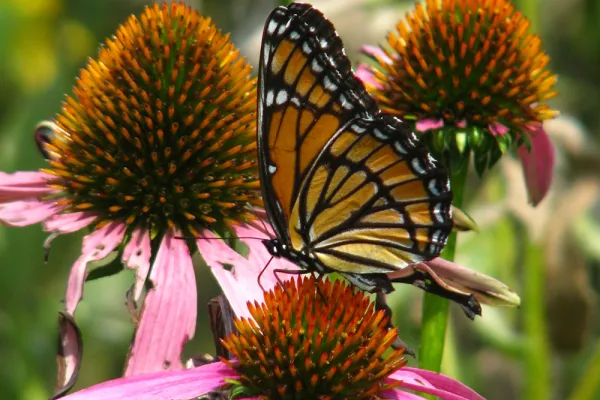On Biodiversity: Six Questions for Desiree Narango
Sustainability
Published March 1, 2021
Many of us enjoy tending to our gardens and choosing the perfect blend of flowers to create an appealing landscape. But those choices may have bigger repercussions, too.
The opening lecture for this year’s annual Bulb Show—all online this year—will focus on the connection between plant choice and conservation. Wildlife ecologist Desiree Narango will discuss “The Birds, the Bees, the Flowers and the Trees: Why Native Plants Matter for Wildlife Conservation,” on Thursday, March 4, at 4 p.m. The virtual event is free and open to the public; preregistration is required.
Narango is a David H. Smith Conservation Research Fellow and a postdoctoral researcher at the University of Massachusetts, Amherst.
Recently, Narango discussed some key points of her work and its importance.
Why is biodiversity becoming increasingly important?
Biodiversity is, and has always been, incredibly important for our health and well-being. Plants and animals provide critical services to us by helping our ecosystems to function and improving our quality of life. Trees do incredible things for us like store carbon, cool temperatures and help keep our air and water clean. And the birds and insects that use those trees help our forests to grow and thrive as well as provide important cultural services to us as—who doesn’t like to hear birds singing in the morning or see butterflies flying by?
Has there been a shift in urgency in recent years to protect plant life both locally and on a global scale?
There is a sense of urgency to protect biodiversity because we are seeing repeated evidence that plants and animals are facing critical declines all around the globe. If we’re going to reverse these declines, we really need to take action now to help protect them wherever we can—even the places we live and work.
The great thing about plants, insects and birds is that if you provide the right habitat for them, they will come back. The trick is getting more people to make these small efforts that will scale up to big changes across wider areas.
Are there common misconceptions people have about the relationships among plants and animals in regards to biodiversity?
When we think about species that need our help, we may often think of endangered species or species in far-off countries. But in reality, there are many local species that need our help too. You don’t have to go to national parks or protected areas in order to see amazing plants and animals, because incredible creatures are all around us all the time, if we provide them with the right habitat they need to thrive. But although green is better than pavement, it’s a misconception that just any plant will do. For lots of wildlife, native plants are a critical resource to support populations.
Why are you excited to give the opening lecture at this year’s Bulb Show?
I’m always thrilled to have the opportunity to have a broad audience of people who are actively making decisions about their yards—folks who are excited about getting their hands dirty and who are looking for the extra information they need to make their gardens better for wildlife. But giving a talk at the Bulb Show is an especially great opportunity this year, with everyone spending so much more time at home and in their yard because of COVID. And to be able to share this virtually means I get the great privilege to speak to a wider and more diverse audience about what they can do to make positive environmental change in their day-to-day lives.
What are some simple steps everyone can take—regardless of the resources available to them—to increase biodiversity in their own yards?
There are a few main points I like to speak to in terms of increasing biodiversity. First, I encourage people to choose native plants for their yards as much as they are able. The majority of our indigenous pollinators and songbirds have very specialized co-evolved relationships with native plants, and when you provide the plants that they’ve adapted to thrive with, you’re more likely to attract them to your yard.
I also like to tell people they can support biodiversity by being “lazy gardeners.” Reducing how often you mow your lawn and favoring trees, shrubs and flowers over lawn cover will provide more habitat and resources for pollinators and songbirds. It’s also good to keep some leaf litter on your lawn instead of raking or bagging it up—it can provide nesting, foraging and hiding spots for wildlife and even improve the health of your plants by releasing nitrogen and other nutrients into your soil!
Are there any key points you hope people take away from your lecture that they can apply to their own lives?
I hope people walk away from the lecture with two things in mind:
Your gardens actually matter. Those simple choices you’re making in your yard are not just creating beautiful scenery for you to look at—your garden can be really ecologically functional, too, and can contribute to local conservation and environmental sustainability in very meaningful ways.
The specific types of flowers that you choose matter as well, as they support specific insects that are a critical resource for many other wildlife. The types of flowers you use in your gardens makes the difference between whether your garden provides enough resources for wildlife throughout the year—if you’re aiming to attract sensitive, specialist species that really need our help, we need to choose the right plants and keep a high diversity of plants in our yards.
While the Smith College Botanic Garden remains closed to the public due to the pandemic, this year’s Bulb Show will be viewable online from March 6 to March 21. More information can be found on Facebook and Instagram.
Viceroy butterfly on coneflower. Photograph by Desirée Narango

